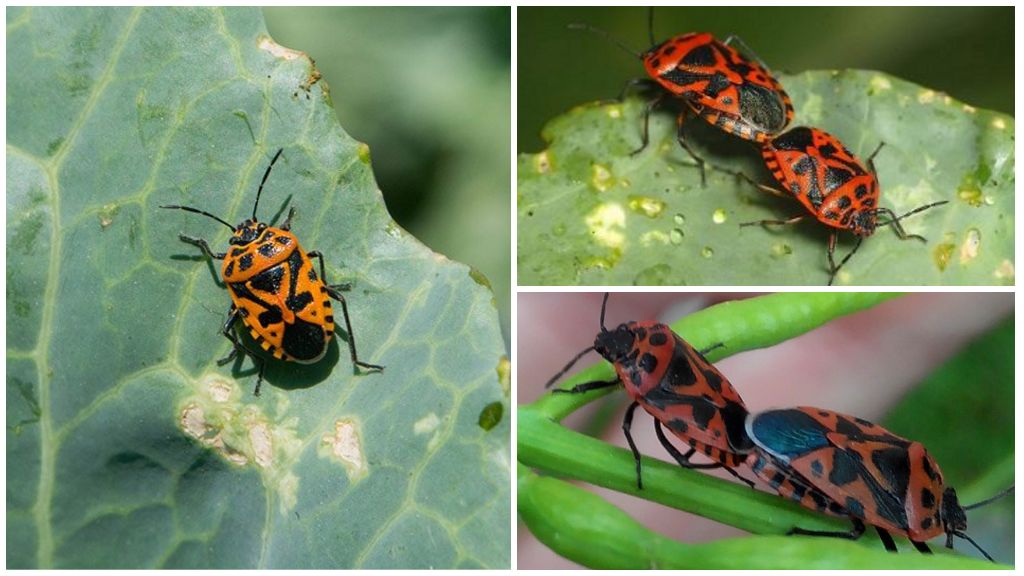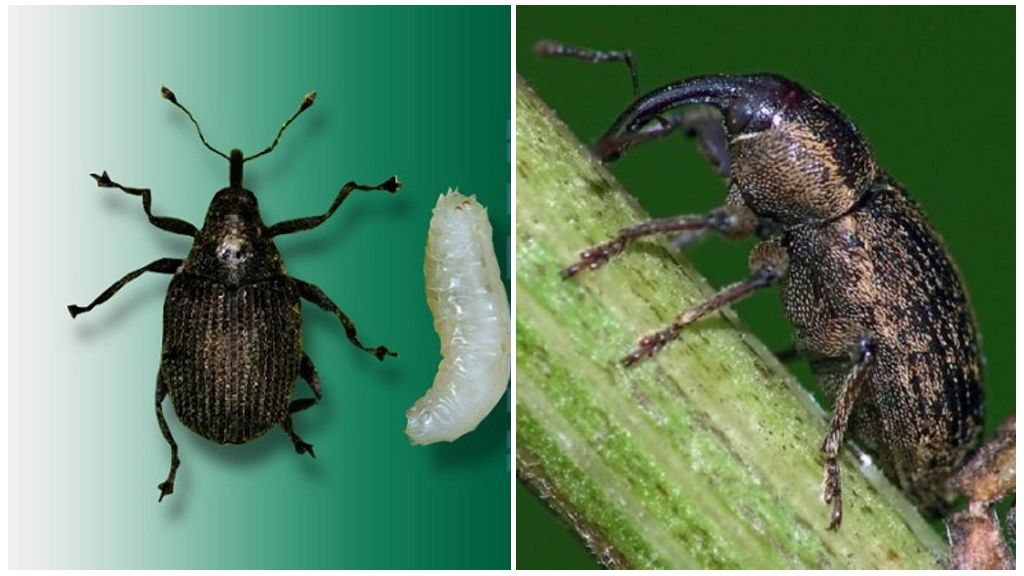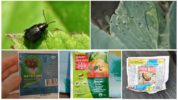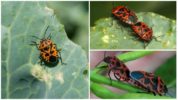- Cabbage flea
- Variegated Shields
- Cabbage Stealthy Hunters
Pests of cabbage in the open ground are represented by all variety. Cruciferous culture attracts all kinds of soil parasites, beetles and fleas that eat green mass. Do not bypass cabbage and flies who prefer to use it for laying eggs. The description of the pests and the damage they cause will help to timely identify the problem and take measures to save the cabbage.
Cabbage flea
Representative of cruciferous fleas, leaf beetle families parasitizes only on crops corresponding to its name. Favorite food supply - cabbage, radish. The sizes of small black fleas do not exceed 2-3 mm. Some individuals have noticeable longitudinal stripes on their backs. There are also small bugs of blue, green. Pests are distinguished by excellent jumping ability. They begin to get active early, as soon as the snow melts, and the temperature reaches 14-15 ° C. Successfully overwintered insects feed on weed cruciferous herbs. When seedlings or seedlings appear, they migrate to a new food object. They live in numerous teams.
On a note!
On cabbage, black fleas are grouped on young leaves, eating away the upper layers, which leads to the formation of holes. With a massive invasion, they are able to destroy cabbage seedlings in a few days, leaving only skeleton leaves from one vein from it. You can notice pests in the warm time of the day.
After mating, the female lays eggs in the upper layers of the soil, from which yellow larvae appear in 10-15 days. Caterpillars are soil pests, those who eat cabbage underground. They damage the root system, causing the plant to become sluggish, even despite heavy watering.
A defeat is recognized as massive if:
- 3-5 bugs were found on seedlings;
- with the formation of leaves of 10 individuals per plant;
- 3-5 fleas when heading out.

With such indicators, it is necessary to fight black bugs with the use of drugs: Decis, Volaton, Actellik, Inta-vir, Karate. With a small number of pests, cabbage is pollinated with ash, tobacco dust, treated with infusions of tops, garlic, onions and other folk remedies.
The main preventive measures include respect for crop rotation, weed removal, the use of covering materials during planting seedlings or emergence of seedlings.
On a note!
Shiny bugs on cabbage can turn out to be shitty leaf beetles, called grandmothers. The harm done is similar to that of cruciferous fleas. The methods of control are identical for both leaf beetles.
Variegated Shields
A large family of pests. Abundance of species makes identification difficult grass bugs. Color can be the most diverse, yellow-black and red-black bugs are more common on cabbage. But there is also a clear common feature - the flat body is covered with a characteristic shield, for which the insects got their name. A photo of the pests is presented below.
Like cruciferous fleas, shields after parasites first parasitize on weeds, migrate to them with the appearance of cultivated plants. The female lays eggs on the inside of the leaves or on the stems in rows. Larvae and adults feed on plant juices.
Signs of defeat cabbage:
- numerous punctures on leaf plates;
- the formation of yellow spots;
- deformation of shoots;
- shedding of ovaries.
What to do:
- Protecting cabbage from insects implies populating the site with natural enemies of bedbugs: trissolcus, mottled phase.
- Planting early varieties reduces the risk of parasitic insects.
- It is recommended to cover seedlings with a special material or plastic bottles. The bottom of the container is pre-cut, and the neck is covered with gauze. This life hack prevents the penetration of pests and provides air access.
- Dusting the aisles with ash or tobacco, treatment with tar solution, infusion of wormwood, dandelions, onions.
- If a decision is made - to collect pests manually, it is necessary to prepare a container for storing bugs. It is extremely difficult to crush them, therefore it is easier to burn them after collection.

Cabbage Stealthy Hunters
Another cabbage beetles. Entomologists distinguish between root and stem. Morphological descriptions are similar. Medium-sized beetles 2-3 mm with a black cover of the body with a metallic sheen. The body is densely covered with gray scales and hairs, making the insect appear earthy. The beetle hides the head tube at rest.
It is possible to determine that pests are secretive hunters by the following signs:
- bugs on cabbage feed on leaves, gnawing round holes in them;
- the larvae make moves in the stems and leaf plate;
- blackening of seedlings with further decay;
- in case of a defeat by a root secretive hunter, galls are formed on the roots.
If cabbage is eaten by black bugs, treatment with Actellik, Fosbezid, Pochin is allowed, Alatar. Autumn plowing and timely removal of weeds will help reduce the number of pests.
On a note!
You can get rid of bugs with a mustard-soap solution. Pour 100 g of dry mustard into 5 l of water, add 100 ml of liquid soap, mix thoroughly and process the cabbage, repeat the procedure after 10 days.

Who else harms cabbage
In addition to the cabbage butterfly known by many vegetable growers, the vegetable attracts a number of pests:
- Aphids - small yellow, green or black insects. May be with or without wings. Parasitize in numerous colonies. Pests are washed off with soapy water. Get rid of aphids possible through folk remedies: infusions of herbs, garlic, onions, a solution of ammonia.
- Garden scoop - a nondescript butterfly. The damage is caused by the gray-brown caterpillars of the scoops, gnawing leaves. In small areas, caterpillars are harvested by hand. On large plantations, cabbage pests have to be controlled by chemicals and biological products: Fitoverm, Spark, Inta-vir.
- Cabbage Moth, whose years begin in May, lays eggs in the lower part of the leaf plate near the veins. Hatched caterpillars gnaw passages, violate the integrity of the apex. Organophosphorus drugs are effective.
- Cabbage fly - an insect of gray color with transparent wings. White larvae gnaw out the course in the stems. You can treat cabbage with a folk remedy: grind 1 kg of freshly picked burdock leaves, pour 5 liters of water. After two days, the infusion is ready.
Pest control is not limited to the use of destructive means. Most harmful individuals spend winter time in soil and plant debris. Deep plowing in the fall can significantly reduce the number of insects on the site. Equally important is the regular mowing of weeds, which are the forage base for many garden pests.






